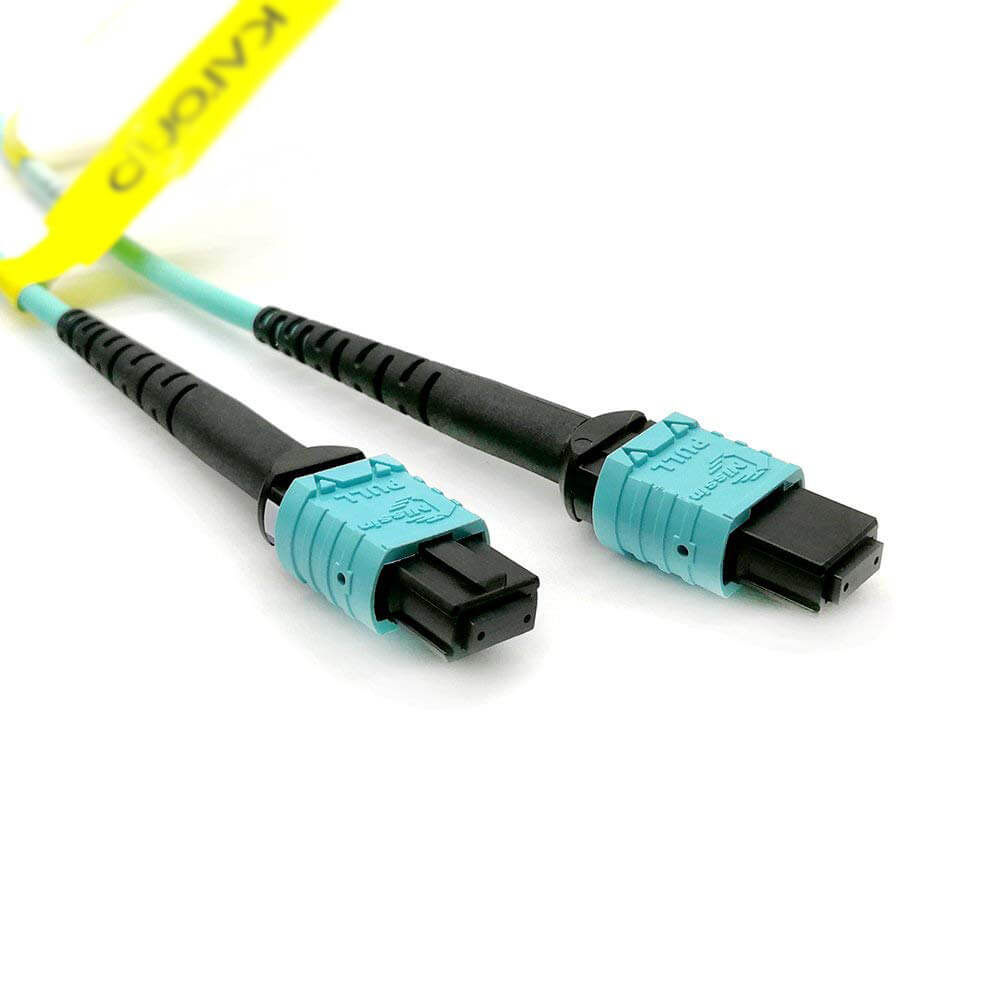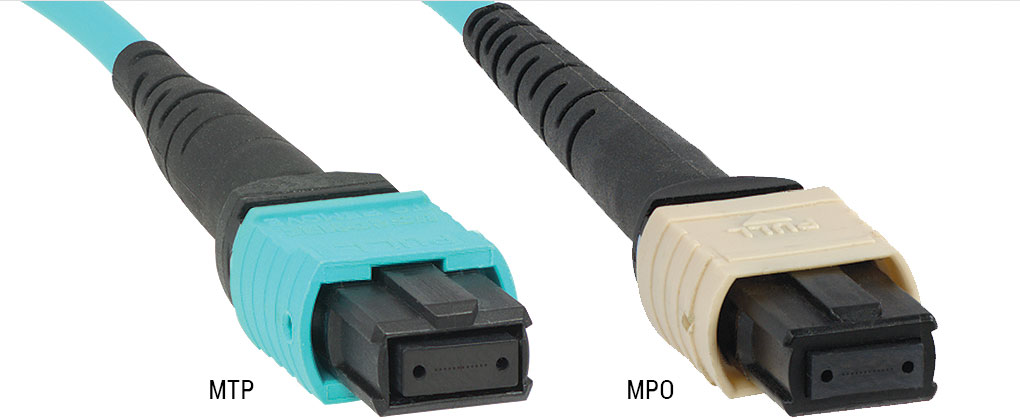What is MPO to MPO fiber cable?
MPO to MPO fiber cable refers to a type of fiber optic cable that uses MPO (multi-fiber push-on) connectors on both ends of the cable. The MPO connector is a type of fiber optic connector that is used to connect multiple fibers in a single connector, which makes it possible to transmit data over multiple fibers simultaneously.
MPO to MPO fiber cables are typically used in high-speed data center applications, such as for connecting switches and servers. These cables can provide very high data rates and support for multiple transmission protocols, including Ethernet and Infiniband.
MPO to MPO fiber cables can have different fiber counts, which refers to the number of individual fibers contained within the cable. For example, an MPO to MPO fiber cable with 12 fibers is a common configuration used in data center applications.

Why we need MPO to MPO fiber cable?
MPO to MPO fiber cable is used in applications where high-density connectivity is required, such as in data centers and high-speed communication networks. There are several reasons why MPO to MPO fiber cables are used:
- High Speed Data Transfer: MPO to MPO fiber cables are capable of transmitting data at high speeds, making them suitable for applications that require high-speed data transfer, such as in data centers.
- High Fiber Count: MPO to MPO fiber cables can support multiple fibers in a single connector, which can significantly reduce the amount of cabling required in a data center or other high-density application.
- Easy Installation: MPO to MPO fiber cables are designed for easy installation, which can save time and money during installation and maintenance.
- Scalability: MPO to MPO fiber cables are scalable and can support a large number of connections in a single cable, making them suitable for applications that require a high level of scalability.
- Space-Saving: MPO to MPO fiber cables are compact and take up less space than traditional fiber cables, which can help to reduce the amount of space required for cabling in a data center or other application.

Different between MPO to MPO fiber cable and MTP to MTP fiber cable?
MPO (multi-fiber push-on) and MTP (multi-fiber termination push-on) are both types of fiber optic connectors that are commonly used in high-speed data center applications. While these connectors may look similar, there are some differences between MPO to MPO and MTP to MTP fiber cables.
The main difference between MPO to MPO and MTP to MTP fiber cables is that MTP connectors are a trademarked version of MPO connectors. MTP connectors are manufactured by US Conec and are designed to be more precise and provide better performance than MPO connectors.
Here are some other key differences between MPO to MPO and MTP to MTP fiber cables:
- Pin Configuration: MTP connectors have a different pin configuration compared to MPO connectors, which means they cannot be interchanged. MTP connectors have a more precise pin arrangement, which helps to reduce insertion loss and improve performance.
- Performance: Due to their more precise pin arrangement, MTP connectors can provide higher performance compared to MPO connectors, particularly in terms of insertion loss and return loss.
- Branding: MTP connectors are trademarked and manufactured by US Conec, while MPO connectors are not.
In summary, while MPO to MPO and MTP to MTP fiber cables may look similar, MTP connectors offer better performance due to their more precise pin configuration. However, MTP cables may be more expensive than MPO cables due to the trademark and manufacturing processes involved.

How to choose MPO to MPO Fiber Cables?
When choosing an MPO to MPO fiber cable, here are some factors to consider:
- Connector Type: MPO connectors come in various types, such as male or female, and single-mode or multimode. Ensure that you choose a cable with connectors that match the equipment you plan to use.
- Cable Length: Determine the distance between the two devices you want to connect and choose a cable with an appropriate length. It’s always best to choose a slightly longer cable than necessary to avoid tension or stretching of the cable.
- Fiber Count: MPO cables come in different fiber counts, such as 8, 12, or 24. The fiber count you choose will depend on the equipment you are using. Ensure that you select a cable with the appropriate fiber count for your application.
- Jacket Type: The jacket type of the cable should be chosen based on the environment it will be used in. For instance, a plenum-rated jacket is required for installation in the plenum space of a building, while an outdoor-rated jacket is necessary for outdoor use.
- Manufacturer Quality: Consider the manufacturer’s reputation, quality of materials used, and any certification they may have, such as UL or ETL.
- Budget: MPO cables vary in price, and you should have a budget in mind when choosing a cable. However, keep in mind that cheaper cables may not always be of the best quality and may not perform as well as more expensive ones.
By considering these factors, you can choose an MPO to MPO fiber cable that will work best for your specific application.
How to choose MPO to MPO fiber cable manufacturer or supplier?
When choosing an MPO to MPO fiber cable manufacturer, there are several factors to consider. Here are some key factors to keep in mind:
- Quality: Look for a manufacturer that produces high-quality MPO to MPO fiber cables. The cables should be made from high-quality materials, with tight tolerances and precise manufacturing processes to ensure optimal performance.
- Compatibility: Check to make sure that the manufacturer’s MPO to MPO fiber cables are compatible with your existing equipment and infrastructure.
- Customization: If you require custom MPO to MPO fiber cables, look for a manufacturer that offers customization services. This can help to ensure that the cables are tailored to your specific needs and requirements.
- Support: Consider the level of support that the manufacturer offers. Do they have knowledgeable technical support staff who can help you with any questions or issues? Do they offer warranties or guarantees for their products?
- Price: Price is always a consideration when choosing a manufacturer, but it’s important to balance price with quality and other factors. Look for a manufacturer that offers competitive pricing without sacrificing quality or service.
- Reputation: Look for a manufacturer with a good reputation in the industry. Check online reviews and testimonials from other customers to get an idea of their experience with the manufacturer.
Overall, choosing the right MPO to MPO fiber cable manufacturer is an important decision that can impact the performance and reliability of your network. By considering these factors, you can make an informed decision and choose a manufacturer that meets your needs and requirements.
 EN
EN ES
ES DE
DE